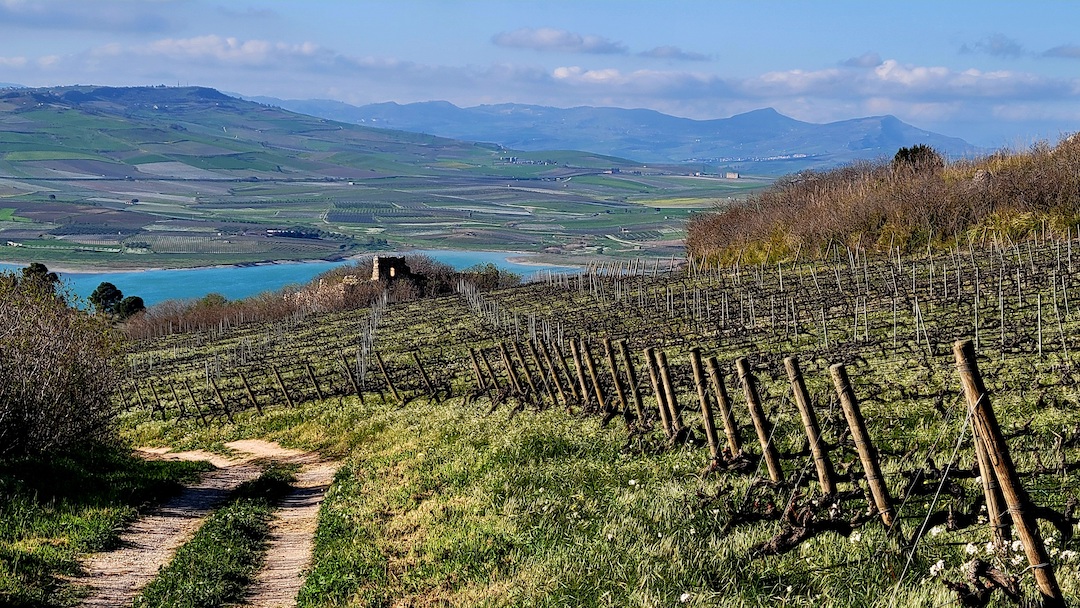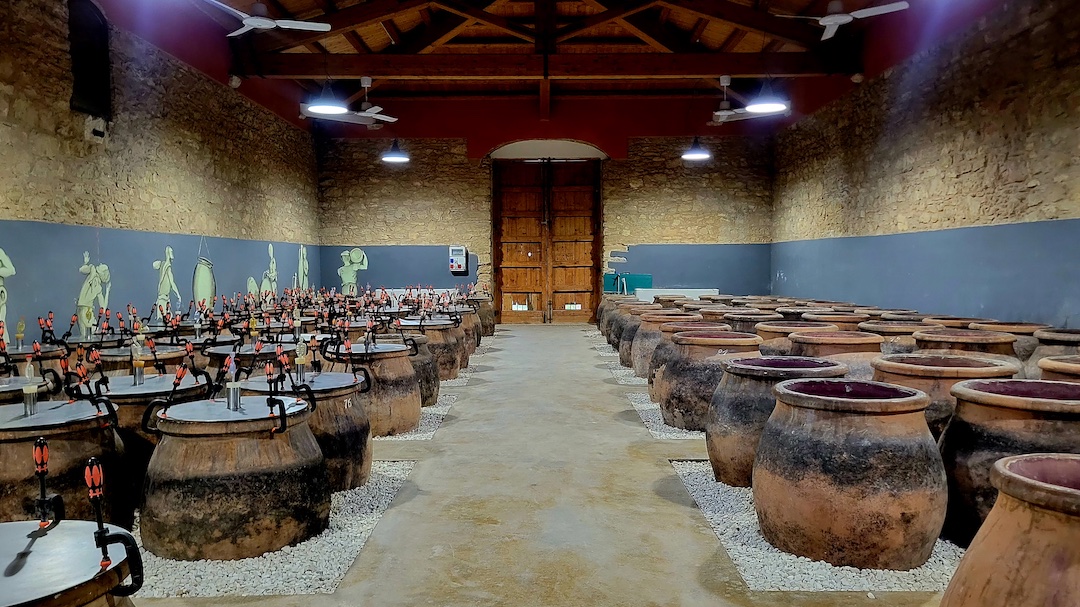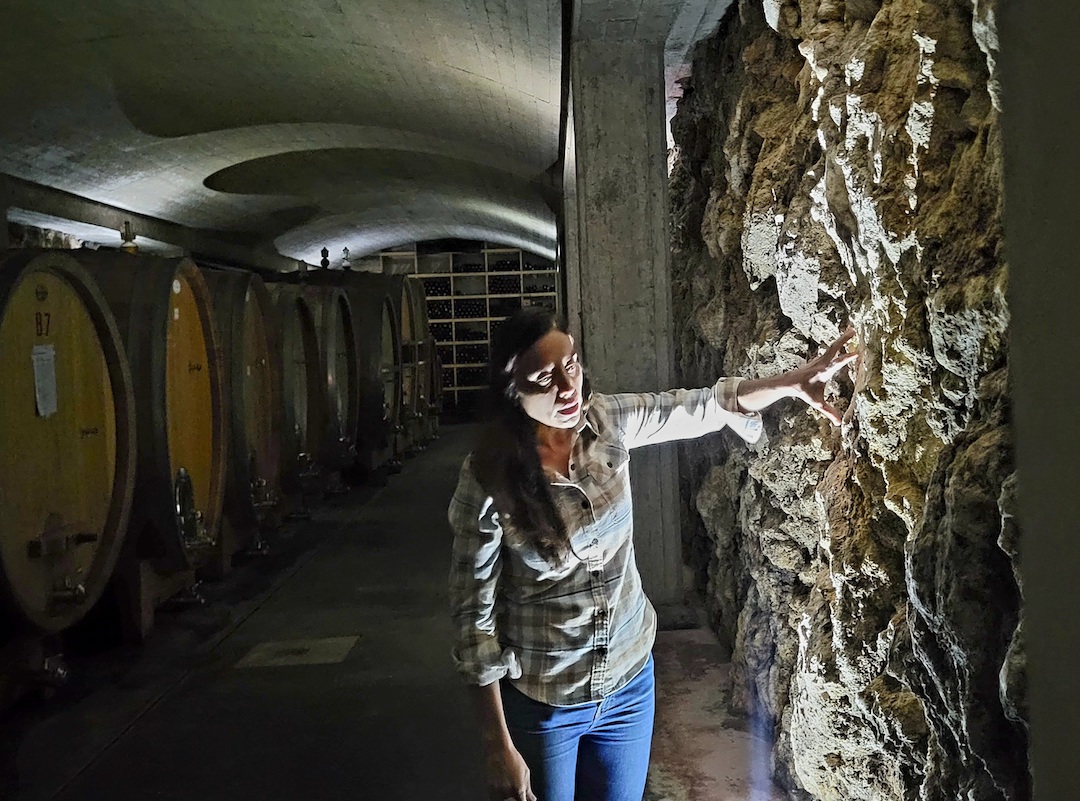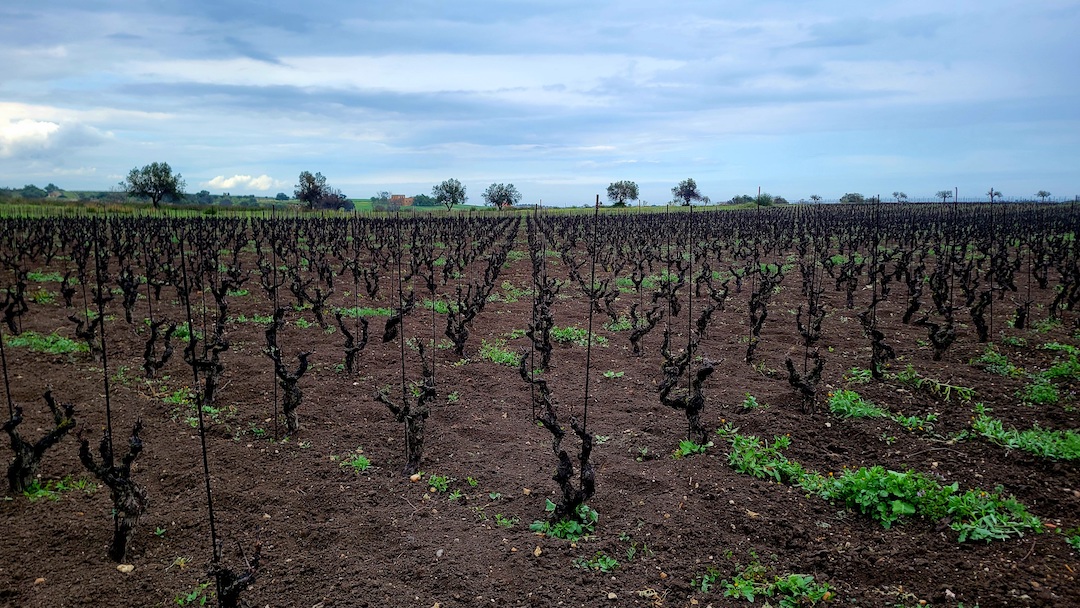Browse using the new Vinous website now. Launch →
Printed by, and for the sole use of . All rights reserved © 2015 Vinous Media
Sicily Excels Despite Mother Nature's Wrath: The 2022 and 2023 Vintages
BY ERIC GUIDO | JULY 1, 2025
Every time I travel to Sicily, I leave with surprising new takeaways about the region. Last year, I spoke in detail about Sicily’s mountainous terrain. Wine lovers often assume that Sicily is flat (with the obvious exception of Mount Etna). However, when one lands in Palermo or Catania, it becomes apparent that mountains are everywhere. The same goes for Sicily’s interior. The only relatively flat areas exist along Sicily’s southwestern coast. This year, Renato de Bartoli, of Marco de Bartoli (who recently started a new project on Mount Etna that I highly recommend ), explained that Sicily not only has the most hillside vineyards in Italy, but also has the second-highest percentage of mountain viticulture of all Italian winegrowing regions (after Trentino-Alto Adige). Access to higher elevations benefits Sicilian winegrowers as warming trends continue. There is a clear trend toward planting highter and higher in the mountains to mitigate the slow increase in temperatures across the island.

Renato de Bartoli in the barrel and amphora rooms at his estate in Marsala.
With each visit and comprehensive tasting in Sicily, I encounter new winemaking projects across the island in previously unfamiliar areas. This is one of the region's best assets, ensuring continued growth in the market. Sicily possesses a plethora of unique, often forgotten terroirs just waiting to be discovered. This frequently comes down to prephylloxera times, as Sicilian wine culture thrived through the late 19th century. The combination of selling bulk wine to local families, shipping wine north to bolster the lighter reds of cooler climates, and producing fine wines kept the Sicilian winemaking industry solvent. Sadly, when phylloxera reached the island and decimated most of its vineyards, materials for grafting onto American rootstocks were scarce. As a result, families with generations of winemaking in their blood either shifted their focus to other agricultural products or left altogether. The areas west of Mount Etna, toward the center of Sicily, are a perfect example of growth potential, featuring higher elevations, biodiversity and a range of soilsTasca d'Almerita, one of the larger wineries in Sicily, has been capitalizing on this resource at their Tenuta Regaleali estate for well over a century, but today, smaller producers are catching on, often returning to their families’ roots and establishing new ventures. It’s a very exciting time in the world of Sicilian wine.
Sicily’s Broad Diversity
I’ve spoken on this topic ad nauseam, so I won’t go too deep here. However, it bears repeating that due to the size of the island, surrounding seas, diverse elevations, warming winds from Africa, cooling currents from the north and multiple islands offshoots (Pantelleria, Salina, Lipari and Vulcano), Sicily can excel with nearly any grape variety from around the world. Sicily’s indigenous grapes and unique interpretations of international varieties offer a lot of choices for consumers. The expansive Sicilia DOC appellation allows winemakers to showcase diverse styles, all with the name of the variety on the front label. This makes it easy for consumers to distinguish between bottlings of Catarratto, Grillo, Zibibbo, Frappato, Nero d’Avola, Perricone or Nerello Mascalese, as well as Cabernet Sauvignon, Cabernet Franc, Syrah and Chardonnay. That said, as much as I love indigenous Sicilian varieties, I often find myself enamored with the Syrahs from the southeast, Cabernet Sauvignons from the rugged center of the island, or stylish Chardonnays from Menfi. Keep an open mind when considering Sicilian wines: they will challenge your preconceptions and overdeliver on pleasure and quality.

Planeta’s Ulmo vineyards, just north of the Menfi coast.
The Next Big Thing
Since I published a separate report on Mount Etna earlier this year, I will focus on what I believe is the next emerging—or should I say, reemerging—region in Sicily: the deep southeastern territories. The Cerasuolo di Vittoria DOCG is proving its worth through winemakers like Paolo Cali, Valle dell’Acate, COS and Arianna Occhipinti. Marabino and Gulfi are spotlighting the single vineyards of Pachino. Nero d’Avola and Frappato are gaining respect for their ability to communicate terroir in unique ways, yielding ageworthy, complex wines. I couldn’t be happier to witness these developments firsthand.
The Southeast is currently the most interesting terroir in Sicily apart from Mount Etna. Winemakers are stepping up their game, improving cleanliness and insisting on higher standards in the vineyards, in addition to placing a new focus on terroir expression and single-vineyard wines. The Vittoria area is special for its soils, which are sandy for the first few inches, then incredibly rocky with a high percentage of limestone. Vittoria is situated about eight kilometers from the sea and eight kilometers from the mountains, at an elevation of about 250 meters. Here, the sea moderates the cooling influences from the mountains and the warm air currents from the African continent—the limestone soils are the cherry on top. This combination is ideal for Nero d’Avola, Sicily’s most important red variety after Nerello Mascalese. Nero d’Avola can reach incredible heights in Vittoria and further southeast in Pachino, giving rise to wines with a strong mineral component and balanced structure. Nero d’Avola also does a fantastic job of communicating terroir. For this report, I encountered wines from the Eloro Pachino DOC that were sourced a mere stone's throw away from each other yet displayed remarkable differences—this is all down to the soils. I expect Eloro Pachino to receive significantly more attention from both consumers and the trade in the years to come. To that end, Matteo Catania, proprietor of the Gulfi winery in Chiaramonte, was recently granted permission to classify Gulfi’s single-vineyard wines under the Pachino DOC. It’s only a matter of time before others catch on.

Subterranean amphorae at COS in Vittoria.
As for Frappato, winemakers look to sandier sites for the best results. Many consumers and Sicilian producers think of Frappato as a fresh, simple variety due to its fruity persona and perfumed aromatics. A large proportion of Sicilian Frappato is made for early consumption and easy drinking. I’ve often compared this style of Frappato to Beaujolais. It certainly fills a niche in the market, but that’s not all that the variety is capable of. In the hands of a winemaker like Arianna Occhipinti, Frapatto reaches its peak. Her single-vineyard wines matured entirely in concrete truly communicate a sense of place, but they also flaunt Frappato’s hauntingly dark aromatics and the complexity the variety can achieve.

Arianna Occhipinti describes the limestone and sandy soils in which Nero d'Avola and Frappato thrive.
That brings me back to the Cerasuolo di Vittoria DOCG. These classic blends marry the structure, power and acidity of Nero d’Avola with the perfumed, fruit-centric characteristics of Frappato. Though enjoyable after only a few years of cellaring, Cerasuolo di Vittoria ages remarkably well. Wite five to ten years of bottle age, Cerasuolo di Vittoria can seriously overdeliver in both satisfaction and value.
An Abundance of Challenging Vintages
Ultimately, the most significant effect of global warming is not the overall rise of worldwide temperatures, but the severe climatic conditions that plague nearly every place on earth, such as extreme drought, once-in-a-lifetime rain events and unheard-of temperature swings in every season. As for winegrowing regions, these ups and downs are often magnified and reflected in every vintage. What’s more, each vintage can vary greatly from place to place within a region of Sicily’s size. The slopes of Etna benefit from the cooling aspects of mountains to the north, bearing little similarity to the conditions in the flat plains of Marsala in the west or the wind-swept beaches of Sirocco in the south. I can only make generalizations and highlight drastic differences from location to location.
To follow up on my previous coverage of the generous 2022 vintage, these ripe, elegant, balanced wines offer both immediate appeal and the underlying harmony for medium-term cellaring. Despite the warm-vintage character of most, the 2022s retain fresh acidity and well-formed tannins. That said, many of the wines are already approachable and already deliver considerable pleasure. The 2022 growing season began with unseasonably warm winter conditions. A subsequent warm and dry period led to drought by mid-June, necessitating irrigation for younger vines in particular. Arid conditions persisted through the summer until August rains provided some relief. Producers generally noted a lack of disease pressure and concerns about sustained dry heat. September saw a return to unseasonable warmth. Vine age proved a significant advantage in this vintage, as did irrigation where available. On Etna, the later harvest dates for Nerello Macalese and Carricante allowed producers to take advantage of cooler conditions and precipitation prior to harvest.

Fuedo Macari exemplifies the terroir of Sicily's extreme southeast.
Whereas the 2022 vintage left winemakers thirsting for rain, the start of the 2023 vintage made them wish it would stop. The 2023 season began with cooler temperatures through April, May and June, coupled with nonstop rain and overcast conditions. As with most of Italy, this resulted in an outbreak of Peronospora (downy mildew). The Peronospora epidemic ravaged all of Sicily, hitting the northeast hardest but sparing the southeast the worst effects. As such, areas like Noto and Vittoria were more successful. Sicily has the highest percentage of organic viticulture in all of Italy, but in 2023, this proved detrimental. Organic treatments did little to ward off Peronospora, as washing off the vines almost as soon as they were applied. The following months of June, July and August were warmer than average and lacked rain, which caused vines to shut down and grape skins to thicken, slowing down maturation for the already reduced crop. A drop in disease pressure was the only silver lining to the dry conditions. As is typically the case, wineries with the resources and determination to manicure their vineyards and select only the best fruit had the most qualitative success, but all suffered reduced yields. The wineries I visited reported an average total loss between 35% and 40%.
Sicily faced extreme drought conditions in 2024. The season left many smaller wineries contemplating irrigation, while most larger estates have already begun installing infrastructure in the aftermath. This is not a matter of whether irrigation is good or bad, but whether wineries are willing to lose entire vintages to drought. As for the quality of the wines, only time will tell, but expect reduced quantities yet again.
I tasted the wines for this article in Sicily in March 2025 and at our offices in New York City.
© 2025, Vinous. No portion of this article may be copied, shared or re-distributed without prior consent from Vinous. Doing so is not only a violation of our copyright, but also threatens the survival of independent wine criticism.
You Might Also Enjoy
An Eruption of Fine Wine on Mount Etna, Eric Guido, May 2025
Unveiling the Diverse Palette of Sicily: New Releases and Beyond, Eric Guido, June 2024
Surpassing Expectations: New Releases from Sicily, Eric Guido, September 2023
Sicily: Welcome to the Revolution, Eric Guido, June 2022
Sicily: The Island Nation, Eric Guido, June 2021
Show all the wines (sorted by score)
- Alessandro di Camporeale
- Ancestrale
- Arianna Occhipinti
- Baglio Oro
- Barone Sergio
- Barraco
- Biscaris
- Campisidrasi
- Cantine Colosi
- Cantine de Gregorio
- Cantine Fina
- Caravaglio
- Caruso & Minini
- Casa Grazia
- Cortese
- Cos
- Criante
- Cristo di Campobello
- Curatolo Arini
- Cusumano
- Cva Canicattì
- Del Grillo
- Di Giovanna
- Donnafugata
- Feudo Montoni
- Feudo Solarìa
- Firriato Winery
- Giovinco
- Giuseppe Cipolla
- Gorghi Tondi
- Gulfi
- Leonarda Tardi
- Marabino
- Marco de Bartoli
- Marco de Bartoli - Terzavia
- Masseria Del Feudo
- Montecarrubo
- Morgante
- Nicolò Grippaldi
- Paolo Calì
- Peri Peri
- Planeta
- Pupillo
- Salvatore Tamburello
- Santa Tresa
- Serra Ferdinandea
- Tanca Nica
- Tasca d'Almerita - Sallier de La Tour
- Tasca d'Almerita - Tenuta Capofaro
- Tasca d'Almerita - Tenuta Regaleali
- Tasca d'Almerita - Tenuta Whitaker
- Tenuta di Castellaro
- Tenute Navarra
- Tenute Orestiadi
- Terra Dives
- Terre di Entella
- Tonnino
- Turi
- Valle Dell'Acate
- Vignedimare
- Zisola
